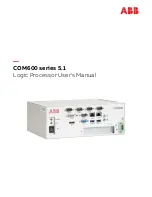
The Harmonizer
®
Programmer’s Manual
©
1999-2008 Eventide, Inc.
Page 29 of 97
Release 1.3
•
Here we see the four
specifier
s for the
meter
module. The
meter
module monitors a control signal output and displays its
value in what looks like an old-school VU meter.
•
The
minimum
specifier
sets the lowest value that will be
displayed, while the
maximum
specifier
sets the highest. The
name
specifier
sets the description of the meter, and the
tag
specifier
sets the description on its
SOFT KEY
(if it has one).
All of these items are selected by you, the program’s
creator, at its inception. The user can’t change any of this stuff.
There is one other type of
specifier
that we’ve deliberately ignored: the sort that controls “repeating
fields." This sort of
specifier
can’t be altered from the
Vsigfile
Specifier
Display
and is discussed in a section all
to itself below.
Audio Inputs
Returning to the
Vsigfile
Specifier
Display
window for the
delay
module that we started out with, the next row
after the
specifier
row displays the audio inputs.
Double clicking on the
MODULE
column calls up yet another
window: the “
Editing Signal Input
”
window. Here you can select
among all of the possible audio
outputs in your patch.
The output you select will be connected to the input you double clicked on to call up the
Editing Signal input
window. If connecting things this way works for you, great, but most folks find it easier to click and
drag in the normal Vsigfile display.
Audio Outputs
The next row displays the audio output. Well, actually it just tells you that it exists. This row is mainly
useful if you want to “hide” the audio output.
Control Inputs
The next row on the other hand, is very useful. It describes the control input for the module. The
type
column tells you what the control input is for
(in this case, ‘delayamt’ controls the amount of delay)
. If no
control output is connected to this control input
(as is the case here)
, the
MODULE
column allows you to set the
delay amount just as you would in the
PARAMETER
area on the Harmonizer. The value you enter is
constrained by the
min
and
max
columns
(‘0’ and ‘1’ in this case)
.
If a control output
is
connected to this control input
(as is the case shown to
the right)
, its module name and output will be displayed.
















































